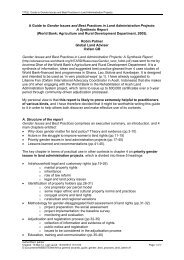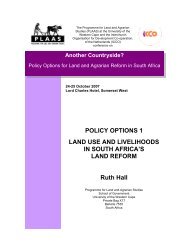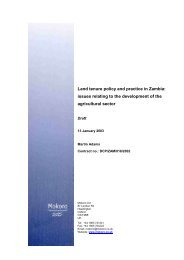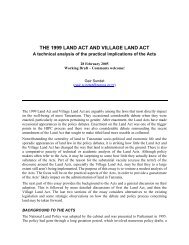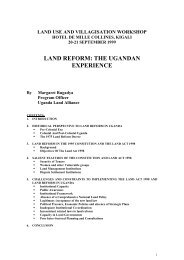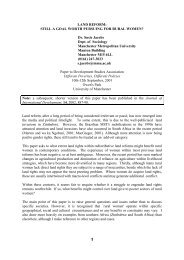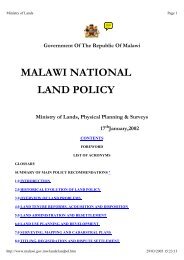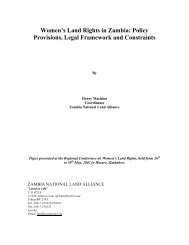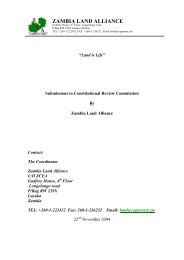NATURAL RESOURCE TENURE IN SOUTHERN AFRICA ... - Mokoro
NATURAL RESOURCE TENURE IN SOUTHERN AFRICA ... - Mokoro
NATURAL RESOURCE TENURE IN SOUTHERN AFRICA ... - Mokoro
You also want an ePaper? Increase the reach of your titles
YUMPU automatically turns print PDFs into web optimized ePapers that Google loves.
<strong>NATURAL</strong> <strong>RESOURCE</strong> <strong>TENURE</strong> <strong>IN</strong> <strong>SOUTHERN</strong> <strong>AFRICA</strong>: An Overview of Key<br />
Issues and Policy Options for Communal Areas in Southern Africa<br />
by Liz Rihoy<br />
1. Purpose of this Brief<br />
This brief provides decision makers with an overview of key issues and policy options for the<br />
development of appropriate tenure systems/property rights to promote the sustainable and<br />
equitable use of natural resources in the communal areas of southern Africa. It provides:<br />
an introduction to key concepts and terminology used within the debate<br />
an overview of current trends<br />
an overview of the critical policy issues and options of relevance to tenurial arrangements<br />
additional recommended literature.<br />
2. What is natural resource tenure?<br />
In the context of this brief, natural resources refers to land and the biological resources that<br />
occur on it. The tenure system in place is the legal and institutional framework which<br />
determines the ways in which property rights are defined and enforced. Tenure is one of the<br />
principal factors determining the way in which resources are managed and used, and the<br />
manner in which the benefits are distributed. Four major categories of tenure are commonly<br />
identified, state property, private property, common property and open access property (see<br />
Box 1 for details).<br />
BOX 1: KEY CONCEPTS AND TERMS<br />
Natural resources – generally refers to all lands, biological, mineral and climatic resources.<br />
However in this brief, as is the general case in southern Africa, natural resources refers to the<br />
land and biological resources occurring upon it.<br />
Tenure – control over resources or the way in which people hold, or do not hold, individually<br />
or collectively, exclusive rights to land and all or part of the natural resources upon it. Tenure<br />
is one of the principal factors determining the way in which resources are managed and used,<br />
and the manner in which the benefits are distributed.<br />
Tenure reform – involves changes in the terms and conditions that govern resource use.<br />
Land reform – a revolutionary process encompassing any redistribution of land. This involves<br />
passing power, property or status from one social group to another.<br />
Property rights – Tenure is also referred to as ‘property rights’. This commonly has two<br />
components:<br />
property rights: entitlements defining rights and duties in the use of natural resources;<br />
property rules: the rules under which those rights and duties are exercised.<br />
property rights/tenure categories - generally four major categories are identified. These<br />
categories are defined on the basis of who exercises exclusive rights to the resource. These<br />
are:<br />
1
State property – on which the public sector exercises rights over resources;<br />
Common property – where rights are exercised by a defined group;<br />
Private/freehold property – where an individual entity has rights; and<br />
Open access (non-property) – or effectively no property, land where no one has defined<br />
rights.<br />
Security of tenure – the need for security of tenure is commonly identified as the most<br />
significant determinant of a sustainable tenurial system. It is commonly associated with four<br />
sets of rights that indicate the relative security of a tenure system as follows:<br />
use rights: are rights to grow crops and trees and raise other resources, livestock or wildlife,<br />
and harvest the products of these;<br />
transfer rights: are rights to transfer the land or use rights, i.e. rights to sell, give, mortgage,<br />
lease, rent or bequeath;<br />
exclusion and inclusion rights: are rights by an individual, group or community to determine<br />
who to exclude or include from the rights discussed above;<br />
Enforcement rights: refer to the legal, institutional and administrative provisions to guarantee<br />
rights.<br />
Common property resources – resources used in common by a defined group.<br />
De jure – by law.<br />
De facto – by practise, irrespective of law.<br />
Institutional arrangements – these include instruments for defining and enforcing property<br />
rights, be they formal procedures, social customs, beliefs or attitudes which determine the<br />
legitimacy and recognition of these rights.<br />
3. The context for natural resource tenure in southern Africa<br />
Natural resource tenure is traditionally viewed as having a narrow technical focus with<br />
implications for agricultural production and natural resource management. However, the<br />
development of appropriate tenurial regimes for natural resources also has cross-cutting<br />
implications for southern Africa’s economic, social, political and environmental<br />
development. It is inextricably linked to the broader issues of equity, democracy and<br />
good governance. Natural resource tenure is a complex and emotional issue with its<br />
roots in colonialism and the struggle for social justice. Box 2 illustrates how people’s<br />
rights to land and other resources has emerged as one of the most important political issues in<br />
the recent history of southern Africa. This role is likely to continue for the foreseeable future<br />
because of the multiplicity of functions that natural resources fulfil in an area where most of<br />
the population still depends on land, water or forests for a living. Developing appropriate<br />
tenure systems is a crucial long-term policy issue essential for the sustainable<br />
development of southern Africa.<br />
BOX 2: HISTORY OF <strong>NATURAL</strong> <strong>RESOURCE</strong> <strong>TENURE</strong> <strong>IN</strong> <strong>SOUTHERN</strong> <strong>AFRICA</strong><br />
Natural resource tenure in southern Africa is a complex and often emotional issue with its<br />
roots in colonialism and the struggle for justice. To understand the political nature of the<br />
2
debate surrounding natural resource tenure and reform in southern Africa it is necessary to<br />
consider the historical context in which the current tenurial arrangements have developed.<br />
Pre-colonial period – Indigenous tenure systems were characterised by diversity and<br />
adaptability enabling them to meet specific local conditions. They were however based on<br />
similar principles of heritable rights of usufruct, held within family lineages, regulated and<br />
sanctioned by customary authorities. Accepted kinship and inheritance rules, varying from<br />
group to group, generally prescribed the access rights of different group members. These<br />
access rights were usually very secure, respected by all in the community.<br />
Colonial period – Southern Africa experienced the most extensive white settlement of any<br />
region in Africa during the colonial era. This period was characterised by an extensive,<br />
racially based ‘land grab’, which served the economic and political aspirations of settlers at<br />
the expense of Africans. This manifested itself in the forced removal of millions from much<br />
of the most productive land and their resettlement into ‘tribal’ or communal lands, producing<br />
the dual land system that is still prevalent today. Not only did this policy alienate many from<br />
the land, it also thoroughly disrupted the indigenous tenure systems. Colonial land policy and<br />
legislation can essentially be viewed as a social engineering tool, developed to ensure that the<br />
distribution of opportunities was skewed along racial lines in favour of settlers.<br />
Post-independence – The core issue at the heart of many of independence struggles was land.<br />
Independent governments have made efforts to address this by undertaking land and tenure<br />
reforms that abolished discrimination on racial grounds. The nature and level of success of<br />
this reform process has varied from country to country. However, it is notable that the dual<br />
land system introduced by the colonists, characterised by the division between commercial<br />
estates and communal lands, continues to exist.<br />
The post-independence era witnessed a trend towards centralisation of authority over natural<br />
resources by governments that generally made themselves the ultimate custodians of<br />
resources. The ideological stance taken was obviously more pronounced and the implications<br />
on tenure most far-reaching in countries such as Angola, Mozambique and Tanzania which<br />
applied socialist tenure formulae. The colonial legacy of undermining indigenous tenure<br />
systems was continued because of the common perception that they represented obstacles to<br />
agricultural modernisation. The role of traditional institutions in communal resource<br />
management decisions was marginalised, largely as a result of the centralisation process and<br />
the common perception that traditional leaders had been co-opted by the colonial powers.<br />
This led to the creation of dual authority structures; traditional systems and state administered<br />
systems. These two systems compete for power and influence, frequently resulting in a power<br />
vacuum leading to the creation of ‘open access’ resource regimes.<br />
4. Key policy issues<br />
Experience throughout the region indicates that one of the key factors affecting the<br />
development of equitable and sustainable tenurial systems for communal areas is the<br />
provision of secure tenure at a level that provides the appropriate incentives for the desired<br />
outcome. The following issues are crucial in this process:<br />
creation of incentives for local people to invest in the resource base through the<br />
decentralisation/devolution of authority over resources to the appropriate local level<br />
development of appropriate institutional arrangements/legal frameworks to facilitate<br />
efficient and effective local management<br />
3
capacity building activities by government at local levels to ensure necessary skills<br />
development and creation of open and representative local institutions<br />
co-ordination of cross-sectoral policies by central government to ensure integrated and<br />
synergistic policy implementation<br />
5. Tenure systems in communal areas of southern Africa: Emerging lessons<br />
One of the major legacies of the colonial era is the dual tenure system still in place throughout<br />
much of southern Africa. This divides land into privately owned, commercial estates and<br />
communally or state owned, predominantly subsistence, areas. Generally, the most<br />
problematic natural resource policy domain is considered to be that within the<br />
communal areas. Communal areas are becoming increasingly crowded, environmentally<br />
degraded and susceptible to drought. The majority of people in southern Africa live in these<br />
areas, holding their land under indigenous customary land tenure systems, irrespective of the<br />
formal legal position under national law. The development of appropriate policies and<br />
legislation - the enabling environment - to stimulate sustainable and equitable land use<br />
practices in these areas is a major challenge facing national governments throughout<br />
the region.<br />
Sustainable land use practices and the sustainable use of natural resources are not solely, or<br />
even largely, determined by physical and biological factors. The crucial determinant of<br />
sustainability is a package in which human needs are bundled with economic, social and<br />
political realities. One of the most pressing factors that affects sustainability of resource use<br />
is tenure. The key elements of ensuring sustainable resource use are described below.<br />
Technical terms are defined in Box 1.<br />
Appropriate incentive structures: Giving people tenure – i.e. conferring ‘custodianship’ or<br />
‘ownership’ - over the resources they live with is often the essential first step in creating<br />
incentives for efficient and sustainable use. Without tenure security, there is no<br />
opportunity or incentive to choose the most profitable or efficient resource use options,<br />
and no reason to ensure long-term sustainability. As long as someone else may reap the<br />
benefits of an investment made, the incentive is not to invest in the first place. However, if<br />
the investor knows that he/she will reap the benefit and that investment in the resource base<br />
will optimise the benefits received, the incentive is to invest and ensure the resource is not<br />
depleted over time. Box 3 provides an example of this principle in action in the communal<br />
lands of Zimbabwe. One of the most significant factors in the search for sustainability then is<br />
the provision of secure tenure at a level that provides the appropriate incentives for the<br />
desired outcome.<br />
BOX 3 – <strong>IN</strong>CENTIVES FOR LOCAL <strong>IN</strong>VESTMENT <strong>IN</strong> THE <strong>RESOURCE</strong> BASE:<br />
THE CAMPFIRE PROGRAMME <strong>IN</strong> ZIMBABWE<br />
The Communal Areas Management Programme for Indigenous Resources (CAMPFIRE)<br />
explores options for rural development and sustainable resource management. It is a<br />
Government of Zimbabwe programme, implemented with the assistance of various local<br />
NGOs. Its objective is to reorganise the control of Zimbabwe’s communal area resources,<br />
providing people with alternative, economically viable options of using their natural<br />
resources. CAMPFIRE emerged in the 1980s with the recognition that, as long as wildlife<br />
remained the property of the state, no one would invest in it as a resource.<br />
4
Sine 1975, Zimbabwe has allowed private property holders to claim ownership of wildlife on<br />
their lands and to benefit from its use. They have since invested in wildlife, taken on wildlife<br />
management responsibilities, diversified risk and coped with drought through wildlife<br />
utilisation.<br />
On communal land however, wildlife remained state property, frequently causing problems<br />
for farmers but offering no profits. Habitat and numbers continued to decline until the<br />
introduction of CAMPFIRE. This provided the legislative framework that enabled people<br />
living in communal lands to exercise the same rights of proprietorship. Tenurial rights over<br />
wildlife were decentralised from central to local government authorities, the Rural District<br />
Councils (RDCs). The RDCs in turn enter into joint management agreements with local<br />
communities, sharing benefits and management functions with them.<br />
Government and NGOs are involved in capacity building activities with local communities.<br />
This includes provision of advice and training for local institutions, including the<br />
development of profitable and sustainable wildlife use strategies.<br />
As a result of the decentralisation of authority over wildlife to local levels, Zimbabwe has<br />
witnessed a three-fold expansion in the land area available for wildlife management from 12<br />
to 33% while wildlife numbers have continued to rise. All RDCs in areas where CAMPFIRE<br />
is economically viable - over 50% of the RDCs in the country - have adopted this approach,<br />
resulting in some 2 million beneficiaries.<br />
Conceptually, CAMPFIRE includes all resources, but practically its focus has always been<br />
wildlife. This policy of decentralising authority over wildlife has now been adopted by<br />
the majority of SADC countries and a number of countries in east and central Africa. In<br />
many of these countries, such as Namibia and Botswana, the policy framework encompasses<br />
a broader spectrum of natural resources. This enables a more integrated approach to natural<br />
resources management in communal areas.<br />
5
Security of tenure: There is general agreement that security of tenure – having the ability<br />
to exclude others from using the resource - is the single most important factor required<br />
to promote efficient and sustainable land and resource use. However, this does not<br />
imply that formal title to resources is essential. Systems of customary tenure are able to<br />
provide adequate security to the individual farmer or household. The particular challenges in<br />
southern Africa result from the historical alienation of communities from indigenous natural<br />
resources, first by colonisation then nationalisation. This has undermined customary systems<br />
in communal areas, resulting in insecure tenure systems and unsustainable resource use<br />
practices.<br />
Secure tenure rights are largely dependent on having the right to exclude others from using<br />
and benefiting from resources and having the ability to enforce these exclusionary rights. The<br />
post-colonial era has witnessed conflicts between two competing authorities; the<br />
traditional structures and the government established structures. The competition for<br />
power and authority between the two has often created a power vacuum enabling a few<br />
powerful vested interests to be the primary beneficiaries. Communal resources have been<br />
designated as state owned with governments accepting the de facto prevalence of customary<br />
tenure, whilst maintaining de jure state ownership. Government has the authority but<br />
responsibility remains with the communities. This control by government of the<br />
authority over communal resources has often resulted in ‘open-access’ situations.<br />
Customary tenurial rules can no longer be enforced, while governments do not have the<br />
resources and capacity to effectively enforce and uphold access and use rights.<br />
Effectively there are no tenure rules. Anyone is able to use resources with no constraints<br />
placed on this use. Use turns into abuse and overexploitation. There is common<br />
agreement in the tenure debate that ‘open access’ situations are to be avoided.<br />
Decentralisation and devolution: Decentralisation refers to the transfer of government<br />
functions from the centre to regional and/or local government. Devolution goes beyond<br />
this as it involves the transfer of authority to local level community institutions.<br />
Decentralisation and devolution are essentially political processes. Conflict may be inherent<br />
given that there are a variety of stockholders with vested interests in maintaining the status<br />
quo.<br />
To address the problem of insecure tenure outlined above, policies need to ensure that<br />
tenurial rights are provided to, or shared with, those who are best placed to enforce them.<br />
Experience has clearly demonstrated that responsibility for land and resources<br />
ultimately lies at the local level and it is at this level that enforcement can be undertaken<br />
most efficiently and cost-effectively. This transfer of authority to appropriate levels can be<br />
achieved through decentralisation of tenurial rights to local government structures and beyond<br />
that through the devolution of rights to local communities.<br />
The identification of the appropriate level at which to vest authority for resources, the<br />
tenurial rights, will vary depending on specific local conditions. However, there are two<br />
important considerations. Firstly, institutional dynamics suggest that the smaller the unit of<br />
proprietorship the better. Increasing numbers introduces increasing possibilities for<br />
misunderstandings, resulting in greater scope for conflict and misappropriation, including<br />
corruption and escalating costs. Secondly, experience has shown that small agencies are<br />
more efficient than large ones. This is largely because self-interest leads individuals to care<br />
for those things over which they have direct authority.<br />
6
Appropriate institutional arrangements: These include instruments for defining and enforcing<br />
property rights, be they formal procedures, social customs, beliefs or attitudes which<br />
determine the legitimacy and recognition of these rights. If decentralisation and devolution<br />
are to be effective in promoting sustainable resource management there have to be<br />
effective management institutions in place at the level to which authority has been<br />
transferred. These institutions have to be genuinely representative, transparent and<br />
accountable to the constituencies that they represent. A critical component of the<br />
decentralisation/devolution process is ensuring that these local level institutions are<br />
effectively empowered through both an appropriate legal framework and the provision<br />
of skills and resources needed to exercise such control. A prerequisite to the successful<br />
functioning of such institutions is a clear and commonly understood definition of the<br />
membership of the group that such institutions represent.<br />
This may require substantial capacity building and skills development activities by various<br />
government ministries. Experience in the region suggests that assistance from NGOs and<br />
the private sector can complement government efforts. Effective co-ordination both within<br />
and between government agencies and with the private/NGO sector is essential to ensure that<br />
conflicting policies and activities do not undermine this process as well as to ensure efficient<br />
use of scarce resources. Experience to date indicates that in several cases despite an effective<br />
legislative framework, implementation has been undermined by lack of a coherent<br />
implementation strategy leading to competition and contradictions between ministries.<br />
Developing strong representative rural institutions is now widely recognised as being<br />
one of the central pillars without which rural economic development cannot take place.<br />
These local institutions are one of the most crucial channels through which otherwise<br />
marginalised rural dwellers can participate in and contribute to national economic<br />
development strategies. They are central to enhancing the process of democratisation and<br />
empowerment of communities.<br />
6. Current policy trends in southern Africa<br />
Three related changes in development policy have stimulated renewed interest in tenure<br />
issues in the recent years. Firstly, in countries such as Mozambique, Tanzania and Angola, the<br />
evolution from centrally planned to market oriented economies has prompted reviews over<br />
what to do with government land in state farms and cooperatives. Secondly, increasing<br />
concern over environmental problems and sustainable natural resource management has<br />
drawn renewed attention to tenure. Thirdly, the shift in development paradigms, emphasising<br />
entrepeneurship and the market with a reduced role for the state, has further stimulated debate<br />
on the strengths and weaknesses of indigenous tenure systems in comparison to<br />
individualised registration systems. This paradigmatic shift has led to a major debate on the<br />
most effective role of the state in managing common property resources.<br />
Recognition of the role of indigenous tenure systems: With the notable exception of<br />
Swaziland, the dominant belief during both the colonial and immediate post-colonial periods<br />
was that systems that provided individual private property rights or state control of land were<br />
more progressive, equitable and economically efficient than those that vested property rights<br />
with communities, as indigenous tenure systems do. However, the adaptability and resilience<br />
demonstrated by indigenous tenure systems and their ability to co-exist with other forms of<br />
tenure, has led to their re-evaluation and a recognition of the important role they can play.<br />
7
Policy and legislative changes have been effected which recognise the legal authority of<br />
traditional institutions in natural resource tenure regimes in Botswana, Lesotho, Malawi,<br />
Namibia, Zimbabwe and Zambia.<br />
Moves towards decentralisation: Global economic trends and Structural Adjustment<br />
Programmes are further undermining the already stretched capacities and resources of<br />
governments to ensure the effective management of state owned resources. This, coupled<br />
with demands brought about through the increasing democratisation within the region, has<br />
strengthened the trend towards decentralisation of authority. Highly centralised<br />
tenurial rights are increasingly recognised as a serious threat to tenure security<br />
throughout the communal lands of southern Africa. Today, most governments are<br />
exploring options for the development of co-management arrangements with communal area<br />
dwellers. The Government of Botswana’s Tribal Land Boards is recognised by many as one<br />
of the most successful experiences with decentralisation of land administration and<br />
democratisation of the process at the local level.<br />
The wildlife sector is one that has been experimenting with decentralisation of authority over<br />
resources through programmes such as LIFE in Namibia, CAMPFIRE in Zimbabwe and<br />
ADMADE in Zambia. These and similar initiatives in Botswana, Malawi, Mozambique and<br />
Tanzania, commonly known as Community Based Natural Resource Management (CBNRM),<br />
seek to provide the legal, institutional and economic frameworks for communities to become<br />
co-managers of communal area resources. In many respects this approach is showing positive<br />
results. However, whilst these programs advocate strong ‘ownership rights’ for communities,<br />
they have been relying upon state permission to experiment rather than a mandate for<br />
decentralisation and tenurial security. Some observers consider that South Africa, and to<br />
some degree Namibia, are currently in the process of taking the ‘next step’ in this approach<br />
through the development of a policy and legislative framework that devolves full tenurial<br />
rights to communities. Box 4 contains a case study of the Makuleke land claim that has<br />
recently been passed in South Africa. This is viewed by some as an important precedent for<br />
the region.<br />
8
BOX 4: DEVOLUTION <strong>IN</strong> SOUTH <strong>AFRICA</strong>: THE MAKULEKE LAND CLAIM<br />
In 1969 three villages belonging to the Makuleke clan were forcibly removed from some<br />
24,000 hectares of land known as the Pafuri Triangle. Most of the Pafuri – in which 9<br />
ecological zones overlap resulting in extremely high biodiversity - was then incorporated into<br />
the Kruger National Park. This move was viewed as a great success by conservationists. To<br />
the Makuleke it was a crushing blow, leaving them disempowered and impoverished. With<br />
the introduction of the new regime in South Africa in 1994, legislation was passed that<br />
enabled the Makuleke to get back their land.<br />
In 1996 the Makuleke lodged a formal claim for the restitution of their land. This claim was<br />
the strongest land claim against a schedule 1 Park and was bound to establish an important<br />
precedent for South Africa. The Pafuri was viewed as an ‘environmental hot spot’ and lay at<br />
the heart of several planned conservation initiatives for the area. Its prominence as a<br />
conservation area meant that decisions on its future would have profound policy implications,<br />
including redefining the term ‘conservation’. This process was fraught with conflict with<br />
many external interest groups, ranging from animal rights to sustainable use advocates,<br />
vocally involving themselves in the negotiation process. The Makuleke found themselves in<br />
the middle of a raging controversy, politically isolated and subjected to intense media<br />
scrutiny.<br />
After an 18 month negotiation process an agreement was reached. This recognised the<br />
Makuleke as owners of the Pafuri. The Makuleke voluntarily agreed to use the land for<br />
conservation purposes, subjecting conservation and land management decisions to a Joint<br />
Management Board, consisting of themselves and the National Parks Board. Essentially, the<br />
Pafuri remains an integral component of the Kruger National Park, but the Makuleke have<br />
exclusive commercial rights over the area. This deal is now viewed as a template for dealing<br />
with similar claims against protected areas throughout South Africa.<br />
The agreement provides the Makuleke with real power in their relationship with the National<br />
Parks Board and has created a ‘win-win’ situation for all. The Pafuri continues to be<br />
maintained as a conservation area and the Makuleke have won back their land. The<br />
responsibility for achieving conservation has now been moved to the grass-roots level,<br />
ensuring that the interests of the Makuleke are now bound up with those of conservation. This<br />
has resulted in them launching several conservation initiatives. These include the<br />
development of an intensive conservation training programme, which integrates modern<br />
approaches with traditional knowledge. This is now the largest training programme of its kind<br />
in southern Africa and has already resulted in some 20 young Makuleke gaining national<br />
diplomas.<br />
From a development perspective, the Makuleke have acquired a significant economic<br />
resource that can be used for the benefit of their community. They have gained considerable<br />
self-confidence as a result of their struggle for the land and this has also led to the<br />
development of strong and respected local management institutions. Considerable local<br />
training is being provided and employment generated.<br />
One issue that retains the interest of many observers is how traditional authority systems will<br />
be accommodated within the new tenurial arrangements emerging in South Africa. Currently,<br />
South African national policy – in line with most other countries recently gaining<br />
‘independence’ - tends to marginalise traditional authority structures. In South Africa, as<br />
9
elsewhere in the region, these had often been co-opted by the apartheid regime. Consequently<br />
new development structures are developed to replace them. Experience from the region has<br />
taught us that this may promote the development of dual power structures which results in<br />
conflict and inefficient resource use. Elsewhere the marginalisation of traditional authorities<br />
is now being reversed. How South Africa will address this remains to be seen.<br />
Recognition of the complexity and implications of natural resource tenure: The technocratic<br />
perspective, which views natural resource tenure as a largely technical issue relevant to<br />
agricultural production and natural resource management, is slowly beginning to make way<br />
for an approach that integrates the socio-economic, cultural and political dimensions of<br />
resource use. This changing perception facilitates a more flexible approach that<br />
acknowledges that there are no correct ‘one size fits all’ solutions. This is conducive to<br />
the development of an environment in which the necessary pragmatic, gradualist and<br />
long term solutions can be sought. This environment allows for the exploration of issues<br />
crucial to the development of systems that will ensure equitable access to resources by<br />
various marginalised social groups, such as women and ethnic minorities.<br />
7. Policy options and implications<br />
A key issue facing policy makers is identification of the appropriate level at which<br />
tenurial rights - the authority and responsibilities - over natural resources should be<br />
held in order to facilitate sustainable management practices, social equity and poverty<br />
alleviation. This can only be identified at a national or sub-national level through a<br />
process of negotiation and consultation with stakeholders. But experience has clearly<br />
demonstrated that those who bear the responsibility for resource management should also<br />
bear the authority, the accountability and the costs involved in decision-making.<br />
Responsibility for the management of land and resources is ultimately exercised at the local<br />
level through the resource users, so too should authority.<br />
Natural resource policies need to be reviewed in light of these experiences to catalyse and<br />
facilitate local action through:<br />
an open and transparent negotiation process with all stakeholders<br />
provision of stronger incentives for local investment in land management<br />
co-ordination of cross-sectoral policies to ensure effective integration and removal of<br />
ambiguities<br />
decentralisation of control over resources from central to local government<br />
authorities<br />
devolution of control over resources to local communities, including the development<br />
of innovative ‘co-management’ and ‘resource sharing’ regimes between the state and<br />
communities<br />
investment in capacity development for local communities and institutions and<br />
investments into dispute resolution mechanisms<br />
recognition of the role and strengths of customary tenure systems in resource<br />
management in communal areas<br />
adherence to the ‘subsidiarity principal’, which states that decisions on management<br />
and administration must be taken as near as possible to where activities are happening.<br />
10
RECOMMENDED READ<strong>IN</strong>G:<br />
Bromley, D.W. and M.M. Cernea, 1988: The Management of Common Property Natural<br />
Resources: Some conceptual and operational fallacies. World Bank discussion paper, 57,<br />
Washington DC, USA.<br />
Bruce, J, et al, 1997: Country Profiles of Land Tenure in Southern Africa, 1996. Land Tenure<br />
Center, University of Wisconsin, USA.<br />
Matowanyika, J.Z.Z and N. Marongwe, 1998: Land and Sustainable Development in<br />
Southern Africa: An exploration of some emerging issues. ZERO – Regional Environment<br />
Organisation. Harare, Zimbabwe.<br />
Murphree, M, 1993: Communities as Resource Management Institutions. Gatekeeper Series,<br />
No 36, Sustainable Agriculture Programme, IIED, London.<br />
Rukuni, M, 1998: Where Should Land Tenure Policy be in Southern Africa? in Proceedings<br />
of a SADC Land Tenure and Decentralisation Workshop. Africa Resources Trust. Harare,<br />
Zimbabwe (In press).<br />
11




